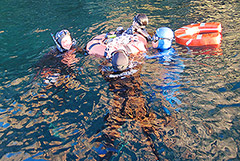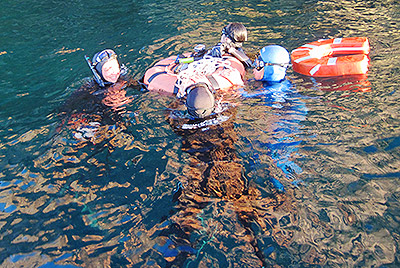Freediving Philippines: Sailing Cruise #2
|
Image courtesy: Juliet Solar
|
Another sailing cruise aboard S/Y Naya
What sets a Freediving Sailing Cruise in the Philippines apart from almost all other South East Asian countries is the tectonic jousts that happen almost daily between the “plates” that cover our Planet’s mantle. The result is that many of the island groups are separated by deep, sometimes very deep, stretches of water, close to shore. Perfect for a Sailing Cruise adventure for freedivers.
Freedivers are different, and on a sailing cruise very different from the other friends we have taken thus far. It is not just that freedivers carry no weighty scuba gear and tanks of compressed air (or more exotic mixes of gases), it is that their perspective on a “dive” is typically more about self-awareness than embracing the stunning filaments of Mother Nature’s creation beneath the waves.
As one of our new Singaporean friends put it: scuba divers dive to explore what is around them; freedivers dive to explore what is within themselves. And this point was made plain on the first stop on our Freediving Cruise from Laiya, Batangas . . . eventual destination: Caticlan, Panay.
To freedive you have to train yourself not to breathe. This is called apnea (or apnoea if you are British). There are various methods employed to achieve apnea, mostly involving some form of meditation combined with breath training on land. The objective is to reduce the CO2 levels at the same time as maintaining muscle function. The bottom line is that the longer you can stop breathing but keep moving, the better opportunity you have to attain a Personal Best (“PB”) depth.
Each dive may take four or six or more than ten minutes, but depths achieved in this time can be impressive, compared to scuba diving. Typically, freedivers will take multiple dives during a session; each freediving session may last many hours. On this particular freediving adventure, the most experienced freedivers achieved in excess of 90 metres depth, within the longest dive; each freediving session was typically two-to-three hours in duration.
Freediving has been around since Man’s first discovery of the bounty of the oceans – for the purpose of fishing and gathering marine organisms for food or trade (e.g. sponges and pearls). Freediving as a recreation and competitive sport has only, perhaps, a 50 year history. Like most extreme sports, without an experienced trainer, freediving can be dangerous; divers may succumb to black-outs or decompression sickness as a result of too many long and or deep dives. In the Philippines, freediving is new.
Freediving Sailing Cruise Destination: Marinduque Island
With the wind favorable for a Freediving Cruise to southern Marinduque Island, we set sail with our old-friend “Sam”, from Austria, and three new friends from Singapore.
This was a learning experience for the crew of sailing yacht Naya, for we wanted to know what was expected of the yacht in order to satisfy the aspirations of freedivers in general, and this group in particular, during the coming six days.
Rule #1, we discovered, was that the water must be deep. How deep? The World record for freediving descent is in excess of 140 metres, so we were told that we had to have something close to that under the keel. The yacht’s depth gauge had recently shown a temperament that meant indicated depths below 10 metres were highly unreliable – OK for sailing but not for freediving. We therefore turned to the Internet and found the answers at the University of California, Santa Cruz, website; thank you UCSC 🙂
The Tres Reyes Island group, southwest of Marinduque Island, was to be our first objective; off the East side of the island of Gaspar, our first anchorage.
We anchored the yacht in about 15 metres at about 4pm, but with the knowledge that much deeper water was close at hand. The group of four freedivers slipped into the water with their gear – no scuba gear, but plenty of floats, lines and weights. Because of the tidal flow, they were soon just specks close to the horizon, over what we believed to be deep-enough water.
Actually we were correct – the water was deep enough – but the group of freedivers were only warming up and so their recorded depths were not so impressive (compared to the World Record), at around 30-60 metres. Nonetheless, we in charge of sailing yacht Naya now had a better idea of expectations and would do even better the following day. One unusual thing that was observed was that the levels of daylight had little impact on the enthusiasm of the divers; darkness was no barrier to enjoyment of freediving.
Freediving Sailing Cruise Destination: Sibale Island
In 1973 the Mactan Ferry was making its way from Cebu to Manila when it ran into some ferocious waves that caused the cargo to shift, the captain decided to try to beach her on the island of Sibale (alternatively known as Maestre de Campo or Conception). The captain’s attempt to beach the ship failed but all aboard were saved. The ship came to rest at an acute angle, against a reef off Barangay Masadya (the “happy” village of Sibale); the Mactan Ferry’s bow at about 20 metres and its stern around 48 metres, with much deep water beyond.
Conflicting suggestions were obtained from local guides as to the precise whereabouts of the Mactan Ferry wreck but, in the end, neither suggestion proved to be accurate. However, this did not pose a real challenge for the freedivers, who were more intent of extending their PB dive-depths than actually viewing the 40-year old wreck. Three hours of freediving later the divers returned to the yacht and we motored into the sheltered anchorage, off the town of Conception, for the night.
Freediving Sailing Cruise Destination: The Tablas Blue Hole
We had been told about the Tablas Blue Hole – the only recognized “blue hole” in the Philippines – but we had never been there. From available reports it was located close to the Gorda Point lighthouse on the northeast tip of Tablas Island.
The sailing breeze from Sibale was almost favorable, even if the tidal flows were not, and we only had to motor that last few miles to come in sight of the Gorda Point lighthouse. On our approach we hailed a local fisherman who pointed, and stated “it is just before the lighthouse”. Well the images on the internet are now presumed false, because none looked like the water we were now cruising – all was deep and no, classic blue hole was evident.
Dispatching two crew ashore off a small sandy cove produced the precise location of the Tablas Blue Hole: 10 meters from the rock at the northern promontory of the sandy cove. You would have missed it if you had blinked.
At slack mid-tide (our objective) the entry to the Tablas Blue Hole is about 6 metres below the surface and, at 4pm in the afternoon, was almost invisible to anyone on the surface.
Our divers were placed above the prescribed location and, in pairs, disappeared from view. Two hours passed with occasional sight of the divers gathering around their floating devices, but it was not until around 7.00pm that we aboard came to understand the wonders of the Tablas Blue Hole dive site.
The Blue Hole is about 23 metres deep, at its base is a tunnel about 15 metres in length extends, before rising into a much shallower chimney. The more experienced freedivers were to achieve the entire extents of the Tablas Blue Hole before their return.
As this dive offered no potential for a “PB” in terms of depth, dive the participants were encouraged to observe outwards rather than inwards. They reported “beautiful corals” and “abundant shoals of fish” and, as the evening veiled the surface in darkness, “numerous fluorescent fish or animals in the depths”. As freedivers rarely take flashlights with them, even at night, identification of that which was fluorescing remained a mystery for another occasion.
The Blue Hole visited, we had the choice: to stay in the little cove for the night or head across the strait to Romblon, a maximum of two hours distant. We chose the latter because the small cove had really solid looking rocks at its perimeter and the yacht had already swung 270 degrees on the tide, and with a freshening breeze expected overnight.
We motored across a choppy strait to the mooring we knew, off Anchor Bay Watersports, Romblon.
Freediving Sailing Cruise Destination: Romblon
Romblon does not immediately come to mind as a suitable freediving destination but that is only because most GPS based charting systems leave out some very interesting detail. A visit to known Romblon tourism sources indicated that a freediving school had recently set up business at “Marble Beach”, adjacent to “San Pedro Beach”, about half-way South along the West Romblon coast.
While the visit to Romblon tourism sources was taking place our freedivers explored the area to the West of Bangud Island – an area shown on charts to be at least 100 metres deep. In the final result, after three hours of diving and drifting with the tidal flows, it was reported that maximum depth was only around 60 metres.
Morning light would allow us to motor to Marble Beach to investigate and meet the Dumagat Freediving School. We anchored off Bonbon beach for the night.
The Dumagat Freediving school is really helpful and have placed marker buoys at approximately 40, 60 and 100 metre depths – all very close to the mooring that must be used, as almost the entire vicinity is a Marine Protected Area.
Day two in Romblon, with the guidance of the Dumagat Freediving school, returned a complete set of four PBs, the deepest being around 90 metres! Our friends were happy . . .
Before nightfall we made our way to a, reported, good snorkeling area at the North end of Lugbung Island before dropping our friends in Romblon Town, so that they would view and or purchase a selection of the fine marble products that have made “Romblon” famous around the World for marble. The snorkeling was the best we had seen in Romblon so far and our friends returned from the marble stores with packages of beautiful mementos.
At 6.30am the following morning we set our sails for Caticlan Port, some 48 miles distant, and enjoyed an almost perfectly glorious sail, finally arriving off the port at around 2.15pm.
Our friends made their way to shore for their various onward ferry or airplane connections and the crew of sailing yacht Naya recounted its new understanding of the world of freediving – better prepared for the next Freediving Sailing Cruise that is sure to happen soon.
A freediving sailing cruise through the Philippines gives you time to enjoy a wide variety of locations and to explore depths that few other Asian destinations can provide. Freediving is not for everyone but if you want to challenge the inner self do go beyond then take the plunge . . .
Freediving & Sailing References
charter a yacht in the Philippines



 Freediving the Tablas Blue Hole
Freediving the Tablas Blue Hole